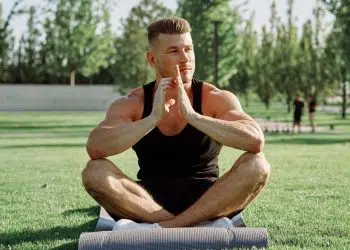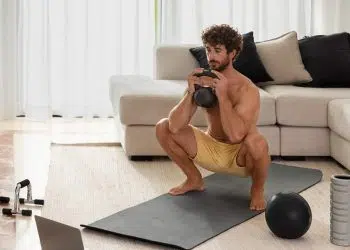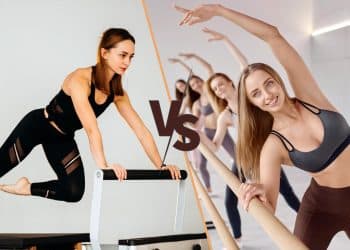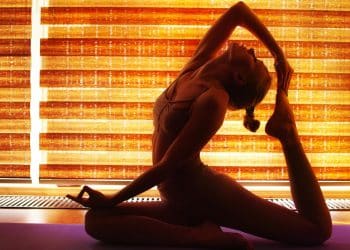The first thing that comes to mind in the half moon pose Ardha Chandrasana is being thrown off balance. And if you’re a beginner, intermediate yogi, or new to this technique, you’re stability and patience will definitely be challenged. But dust yourself off, focus, breathe, and bring yourself back into the pose, teaching yourself patience, and persistence in the process.
Being unilateral in nature, half moon pose shifts your weight onto one side, strengthening the standing leg, plus the hips, pelvis, and core, as it requires more overall muscular demand. But perhaps the greatest difficulty is maintaining the lateral cartwheel position in a plane of movement we rarely tap into.
But the half moon pose is a must-have technique in your posing regime, and we have some amazing technique tips and variations below.
Muscles Involved During Half Moon Yoga Pose
Balance may seem like its own thing, but that couldn’t be further from the truth. We need help from certain muscles to maintain the desired positions. The half moon is almost a full-body movement as it involves coordination and stability from several body parts.

Legs
Akin to a hip hinge movement like stiff legged deadlifts, the hamstrings (muscles on the rear on your thigh) stretch and load up, while the quadriceps (five headed anterior thigh muscles) keep the knee straight, and leg strong, and the calves root down to help posture and balance.
Level Up Your Fitness: Join our 💪 strong community in Fitness Volt Newsletter. Get daily inspiration, expert-backed workouts, nutrition tips, the latest in strength sports, and the support you need to reach your goals. Subscribe for free!
Glutes (medius)
You especially need strong glute medius muscles, which are one of the three muscles in your butt. That’s because these muscles, found in the lateral upper buttock, externally rotate the hip, and play an essential role in stabilizing the lower limbs and pelvis, which are highly activated in the half moon pose.
Core
You can see in half moon that the upper body leans forward at the hips. As a result, the muscles in your core have to take over to maintain the torso in proper position. These include the deeper and more superficial absominals that stabilize the spine, erectors that allow us to bend and stand up, and obliques that work during lateral motions and rotation.
How To Do Half Moon Pose Ardha Chandrasana
The half moon pose may appear easy enough so long as you have the flexibility. But there’s a lot more to it, and you may need to work on your technique before you can get it down pat!
Note: The following video demonstration is the simple, straightforward version of half moon pose. There are longer versions that involve more warming up, pre pose techniques, etc.
Steps
- Come into a front forward leaning lunge with the right foot in front, pointing straight forward, and back foot turned outward to the left.
- Reach the left arm behind you and grab the back of the left leg/hip.
- Reach the right arm to the floor and lean onto your finger tips, with the hand directly under the shoulder.
- Rise up onto the front leg, and lift the rear leg up parallel to the floor. The lifted foot should be pointed to the left with the feet flexed by pulling the toes up toward the shin.
- Root down into the floor with the standing leg by pressing with the four corners of your feet, and extend the bottom leg.
- While looking down at the floor, extend the top arm vertical with the fingers pointing straight up toward the sky.
- Now you can adjust your gaze to the side or look up at the top hand to challenge your balance further.
- You’ll then perform the same technique but on the opposite leg.
Tips
- When you feel advanced enough, try the half moon pose without touching the ground.
- The half moon pose is commonly performed as a transition from or into another similar standing balancing hip focused posture, like triangle pose, for example.
- An effective trick to get your body into the right position is to perform half moon pose with the back side of your body against a wall. It gives you stability, keeps everything in line and tells you where you need to straighten up.
- Use a yoga block to elevate your upper body and free up space through the hips as you learn the half moon pose. You can also use a chair if a yoga block is still too low.
- The half moon pose is an open hip posture, therefore, your feet position is very importance. The lead foot should point straight forward toward the head, while the back foot needs to face out to the side.
This Exercise
- Target muscle groups: Legs, glutes, hips, core
- Type: Yoga
- Equipment: Mat
- Difficulty: Intermediate
Benefits of Half Moon Pose Ardha Chandrasana
Balance based exercises are so beneficial alone, but you there’s much more to the moon pose that make it worth including in your yoga routine.
Build foundational strength and functional ability
Half moon ardha chandrasana is a strong pose that requires a solid and rooted foundation in your feet, ankles, legs, and hips. You may be wobbly in the beginning, but as you become more coordinated and in tune with your body, you’ll create a more unshakeable base. This will carry over to your athletic activities, weight room lifts, maintaining good walking balance, and preventing falls, which increases as we age.
The unilateral (affecting one side at a time) nature of the half moon pose is a good test of left to right side balance, and you’ll get instant feedback, so that you can work on fixing any imbalances.
Keep your patience
Patience combined with persistence is the secret recipe for progress and long term results. An intermediate posture, half moon isn’t as easy as balancing on one foot. In fact, it looks something like a ballet or gymnastics technique. Not to mention, it’s a lateral facing posture which is harder. Many who attempt the half moon will struggle and it will take time and patience to get right.
Great for those who sit too long
In modern culture, sitting for 4+ hours straight is pretty standard, with desk and remote type jobs being the norm, and electronic devices taking up most of our time. Implementing a light yoga routine that forces us to counteract the constant sitting and lying positions of our legs and hips is a very good idea.
You probably won’t start with the half moon pose as a beginner, but it is something to work up to as an intermediate.
Common Mistakes When Performing Half Moon Pose Ardha Chandrasana
Below are some common mistakes and reasons why you shouldn’t make them.
Pivoting the standing foot inward
It may feel more comfortable to pivot or turn the standing foot inward. This happens for a few reasons, but they should be identified and fixed.
The first is that many feel it gives them a better sense of balance control. But this is a manifestation of either tight hips or lack of balance ability. But by doing this, you’re actually closing the hip joint, but we want to keep the standing leg externally rotated, to keep the hips open.
Level Up Your Fitness: Join our 💪 strong community in Fitness Volt Newsletter. Get daily inspiration, expert-backed workouts, nutrition tips, the latest in strength sports, and the support you need to reach your goals. Subscribe for free!
But that’s also where it’s useful to have a yoga block for balance, so that you can more easily keep the lead foot forward.
Letting the raised leg move behind the hip
Something else that often happens is that the top, lifted leg moves back behind the hips. From the half moon pose, take a peek at the top leg and see of you can see the feet. If not, you know to move them slightly forward in line with your hips. You can also use a wall to train keeping your leg in proper alignment.
Slumping forward
We could see this one being very common, where the person simply leans forward and slumps over, without actively engaging the upper body.
To easily fix this, push your hand into the floor or your block to straighten the arm, roll the shoulder back, and then do the same for the top arm, retracting the shoulder toward the middle back. That’s how you’ll achieve the nice straight line in the arms and shoulders.
Variations of Half Moon Pose Ardha Chandrasana
Whether you’re still trying to figure out the half moon pose, or are ready for a more challenging variation with a twist (pun intended), definitely give these poses a try.
Half moon against a wall
We briefly mentioned this variation in the tips section of this guide. And it really is one of the easiest ways to get immediate feedback on your technique, but it’s also like having training wheels.
The wall provides stability, and reinforces correct half moon posture, allowing you to feel any gaps that need to be filled. It’s especially helpful for keeping the shoulders back and retracted, and keeping the top leg over the hips, as the wall stops it from moving back.
Knee down half moon pose
Here’s one outside of the box… try the half moon on half a leg! Removing a lot of the stability requirements, you’ll be lower to the ground, with the bottom shin behind you for better support. Most people can do this pose, even if you’re a beginner. But it’s a perfect training technique to help you improve your alignment and strengthen your foundation.
Steps
- Sit in a tall kneeling position on your knees in the center of the mat.
- Dig the right knee firmly into the mat and point it outward toward the top of the mat while not moving the left knee.
- Then place your right hand down on your right side, either flat on the palm or on the fingertips.
- Shift your weight to the right hand and knee so your body is leaning sideways onto that side.
- Now extend the left leg and place the inside of your foot or toes are on the mat.
- Activate your core, then raise the left leg up, tensing the glutes and outer thigh. Flex the toes by pulling them up toward the shin.
- Your entire body should now be facing sideways, with the hips fully open, and stacked.
- Push into the floor with your right knee and foot, and keep the core and lifted leg strong.
- The you can simply reach the top arm overhead in line with the bottom arm.
- Switch sides and do it again.
Revolved moon pose (parivrtta ardha chandrasana)
While the half moon is an open hip variation, the revolved moon pose is closed hip. In fact, it’s more similar to the warrior III pose, so the feet and legs are facing the same direction, unlike half moon where the lead foot is forward and the top foot points sideways.
Revolved moon can be very difficult though, forcing the person to flatten the palm on the floor, and making it hard to get the legs in position, causing a sagging pelvis.
The best thing to do here is use a yoga block, and make sure it’s placed directly under the shoulder. This will allow you to create more space in the lower body so that it’s easier to lift the back leg, which is the biggest limitation in the revolved moon technique. You want to keep the hips as neutral as possible, otherwise, the lifted leg will be pulled down, and that’s not what you want.
Tips
- The glutes play a strong role in keeping the lifted leg up and firm in position.
- The twist should occur in the torso, not the hips.
- While a variation, it’s best not to program revolved moon and half moon back to back.
Bound revolved half moon pose (baddha parivrtta ardha chandrasana)
If you want to get deeper in a similar pose, this is one good way to do it. It combines elements of warrior III pose which keeps the hips closed, then you bind one leg, and twist into the opposite side.
Steps
- Stand at the top of the mat with your feet close together, hands on the hips, shoulders down, and chest upright.
- Soften your right knee, and bend it slightly.
- Hinge forward at the hips and lean your upper body forward. Lift the left leg up behind you with the toes pointed down to the floor.
- Reach down with your left arm extended and place your hand on the floor under the left shoulder.
- Then reach back with your right hand, bend your left leg and grab the left foot. Keep your hips neutral and facing down toward the floor. Do not allow your body to rotate at any point during the pose.
- Lift the left knee up and drop the head lower.
- Now slowly twist your upper body as far as you can to the right. From here, go as deep as you can feel you can safely.
- To come out of the pose, let the left foot come down to the floor, and transition to sitting on the mat.
- Make sure to do the same thing but with the legs in opposite positions.
Chapasana or sugar cane pose
It’s hard to imagine what this pose looks like but if you do it correctly, you’ll resemble a bowed out sugar cane. Chapasana is also a type of backbend although performed from a side facing position, or half moon pose.
Let’s check out how it’s done.
Steps
- Come into the half moon pose.
- Bend the top leg back, and grab the left foot with your left hand.
- Now curl the lower butt in and under, push the tailbone forward, pull your head all the way back back, and open up the chest. Your body should be bent back in what looks like a sugar cane bow.
- Release the leg, return the feet to the floor, and bring the hands down to the floor under the shoulders.
- Repeat on the opposite side.
Pro tip: If you cannot easily reach back and grab the top foot, pull the top knee into the chest first, then grab the leg, and slide it up to the foot as shown in the video demonstration below.
Wrapping Up
Half moon pose ardha chandrasana is not an easy technique, but don’t get bent out of shape so easily (at least not until you’re ready for the sugar cane pose variation). You’ll need a pair of loose hamstrings, strong quads and glutes, hip mobility, good balance, and most importantly patience, to master this technique.
But what’s nice about half moon is there are many training wheel variations from using a wall to a yoga block and even a chair, or kneeling technique. Then, when you crave a new challenge, try a revolved half moon or bend yourself into a sugar cane!











